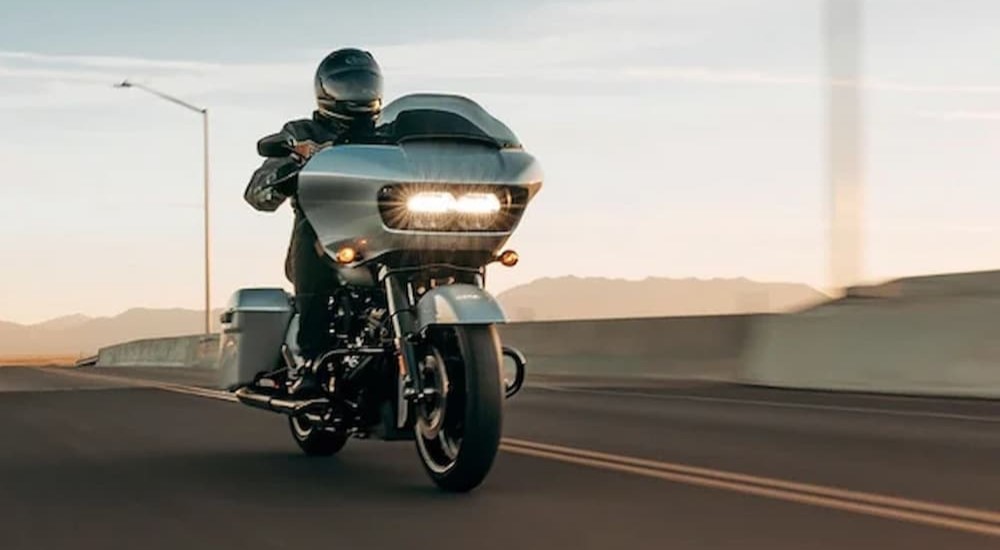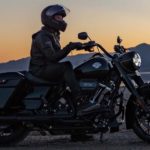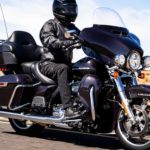The 2023 Harley-Davidson Road Glide Special continues a rich legacy in the Harley-Davidson lineup of Grand American Touring bikes. Harley-Davidson built the segment from the ground up, introducing riders to luxurious touring bikes that offer the iconic performance expected of a Harley-Davidson road warrior with the comforts and capability to venture further than imaginable. This legacy has been decades in the making, with Harley-Davidson debuting the Tour Glide in 1979 and setting the stage for its successor, the Road Glide, in 1998.
The Road Glide and its more powerful sibling, the Road Glide Special, differentiate themselves in the Harley-Davidson lineup by their fairings. Their biggest rivals, the Electra Glide and Street Glide, built their identities on their fork-mounted fairings, commonly known as batwing fairings. The Road Glide and Road Glide Special feature frame-mounted or sharknose fairings. So, what’s the difference, and why does it matter? In the motorcycle realm, it’s an incredibly divisive design that offers a unique riding experience, with some arguing one is better and more intuitive than the other.

What’s a Fairing? How Does It Work?
Think of a fairing as the wrapper or shield around a motorcycle. Bikes without fairings are considered “naked,” while those with fairings boast a broad spectrum of designs, from the sharknose and batwing to half, full, quarter, etc. But what does any of this matter when you’re in the saddle?
Aerodynamics play an integral role in motorcycle performance. Manufacturers in the 1920s recognized as much and began streamlining their designs. However, even then, several aspects proved impossible to alter. For example, even a motorcycle with a sleek silhouette is affected by a rider in the saddle. There’s no way around it because the rider increases the bike’s power-to-weight ratio and affects its aerodynamics or how air passes over the motorcycle when traveling. The rider and other essential motorcycle components, like the frame, handlebars, engine, etc., act as speed bumps, increasing drag and limiting the bike’s optimal capability.
As motorcycle designs evolved, manufacturers looked for ways to reduce drag, turning to the aircraft industry for inspiration. Airplanes rely on fairings to streamline airflow over the body, smoothing the spaces or gaps between the various parts of an aircraft. It’s not only a sleeker appearance but also aerodynamic. So, why not apply the same to motorcycles?
Although fairings are nothing more than protective panels, the application proved far from straightforward, as the earliest iterations of fairings were problematic. They heightened instability and caused vibrations in the handlebars. As a result, they did little to improve aerodynamics or remedy rider discomfort.
It wasn’t until the late 1970s that fairings finally became something substantial. BMW made the fairing standard on the R100RS in 1976, helping popularize the use of fairings to improve performance and enhance rider comfort. From there, fairings became a staple on various models, from touring to sport bikes, and permanently differentiated themselves from their “naked” counterparts.

Batwing vs. Sharknose: The Tale of Two Fairings
There are many different types of fairings in the motorcycle industry, from the long-banned Dustbin to the dolphin, full, half, quarter, handlebar, and even tail fairings. In the Harley-Davidson lineup, the batwing and sharknose fairings differentiate models like the 2023 Road Glide Special, Electra Glide, and Street Glide. But what’s the difference?
The batwing fairing is a signature Harley-Davidson design where the fairing is mounted to the fork, as seen on models like the Electra Glide and Street Glide. The design is often praised for its intuitiveness because turning is as natural as leaning into the turn and pointing the bike where you want it to go. But aren’t all turns that straightforward? With a batwing fairing, the front wheel, handlebar, and fairing move in unison as you make the turn, explaining the batwing’s preference among so many riders.
The Road Glide Special distinguishes itself from Grand American Touring bikes like the Electra Glide by relying on a sharknose or frame-mounted fairing. Instead of the fairing mounted to the forks, it’s mounted to the bike’s frame. This keeps the fairing in a fixed position. Personally, the easiest way to differentiate the fairings is to think of Batman himself freely moving through Gotham as opposed to a shark swimming a direct path to its prey. Silly as it may be, it’s how I keep the two straight.

Rider Benefits
Now, there’s the question, “Why does it matter?” Fairings were initially adopted to improve aerodynamics, but motorcycle manufacturers quickly discovered fairings also enhanced rider comfort. As a protective cover, the fairing doesn’t simply streamline the motorcycle’s design but also creates a pocket around the cockpit and adds another level of protection. How so?
Comfort
The fairing creates a pocket filled with calmer air, which reduces buffeting or the effect of wind hitting the rider. After long rides, buffeting heightens rider fatigue because your head, shoulders, and upper body are constantly fighting against the moving air. There are even more benefits when the fairing protects the handlebars because it diverts wind and other elements away from your hands. This protection is especially beneficial in the rain, colder temperatures, or wintry precipitation because it acts as a barrier that forces that rain, sleet, snow, or cold wind away from the handlebars and your hands.
Handling
Beyond the perks of reducing rider fatigue, fairings also play an integral role in how a motorcycle handles and responds. Because of this, riders often have a preference, pledging their loyalty to the intuitive batwing fairings or refusing to ride anything that doesn’t have a sharknose fairing. The passion and divisiveness seem extreme, but it’s understandable considering the vastly different experiences the batwing and sharknose fairing offer.
The batwing fairing, found on models like the Street Glide and Electra Glide, is intuitive in the sense that the fairing turns with you when you move the handlebars. However, this also puts the entire weight of the front end on the handlebars. With a Harley-Davidson like the Electra Glide, this typically means the additional weight of the infotainment system, speakers, instrument gauges, and any accessories mounted to the handlebars.
Alternatively, the sharknose fairing is often praised for offering the same responsiveness as a naked bike because of its frame-mounted position. This makes a significant difference because it transfers the weight of the fairing to the frame rather than the handlebars. As a result, turning the Road Glide Special is nearly effortless, with the handlebars easily moving in either direction because there isn’t the additional weight of the fairing and other fairing-mounted accouterments like the gauges, speakers, or infotainment system.

Batwing or Sharknose: What Will You Choose?
Harley-Davidson riders are incredibly loyal and passionate. They take pride in their bikes because they know what it means to ride a Harley-Davidson. Moreover, they’ve logged many miles in the saddle and have the experience to understand and recognize what they value most in their motorcycles. This experience is at the heart of many debates about fairings and which is better, the sharknose or the batwing.
The debate is perpetual, with riders vowing one is better than the other and citing every reason why. However, it’s critical to remember that no one is necessarily right or wrong. It’s a matter of preference, just as the riders who swear by their naked bikes would never dream of hitting the road with a fairing-clad road warrior. This makes bikes like the Road Glide Special and its siblings a personal, albeit heavily debatable, choice that gives every rider a topic of conversation wherever the road takes them.




